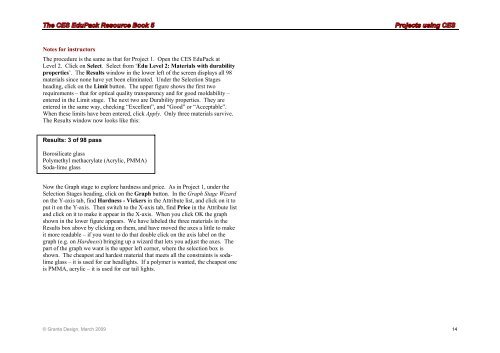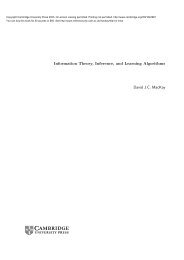Projects Using CES EduPack - MAELabs UCSD
Projects Using CES EduPack - MAELabs UCSD
Projects Using CES EduPack - MAELabs UCSD
Create successful ePaper yourself
Turn your PDF publications into a flip-book with our unique Google optimized e-Paper software.
Notes for instructors<br />
The procedure is the same as that for Project 1. Open the <strong>CES</strong> <strong>EduPack</strong> at<br />
Level 2. Click on Select. Select from ‘Edu Level 2: Materials with durability<br />
properties’. The Results window in the lower left of the screen displays all 98<br />
materials since none have yet been eliminated. Under the Selection Stages<br />
heading, click on the Limit button. The upper figure shows the first two<br />
requirements – that for optical quality transparency and for good moldability –<br />
entered in the Limit stage. The next two are Durability properties. They are<br />
entered in the same way, checking “Excellent”, and “Good” or “Acceptable”.<br />
When these limits have been entered, click Apply. Only three materials survive.<br />
The Results window now looks like this:<br />
Results: 3 of 98 pass<br />
Borosilicate glass<br />
Polymethyl methacrylate (Acrylic, PMMA)<br />
Soda-lime glass<br />
Now the Graph stage to explore hardness and price. As in Project 1, under the<br />
Selection Stages heading, click on the Graph button. In the Graph Stage Wizard<br />
on the Y-axis tab, find Hardness - Vickers in the Attribute list, and click on it to<br />
put it on the Y-axis. Then switch to the X-axis tab, find Price in the Attribute list<br />
and click on it to make it appear in the X-axis. When you click OK the graph<br />
shown in the lower figure appears. We have labeled the three materials in the<br />
Results box above by clicking on them, and have moved the axes a little to make<br />
it more readable – if you want to do that double click on the axis label on the<br />
graph (e.g. on Hardness) bringing up a wizard that lets you adjust the axes. The<br />
part of the graph we want is the upper left corner, where the selection box is<br />
shown. The cheapest and hardest material that meets all the constraints is sodalime<br />
glass – it is used for car headlights. If a polymer is wanted, the cheapest one<br />
is PMMA, acrylic – it is used for car tail lights.<br />
© Granta Design, March 2009 14
















